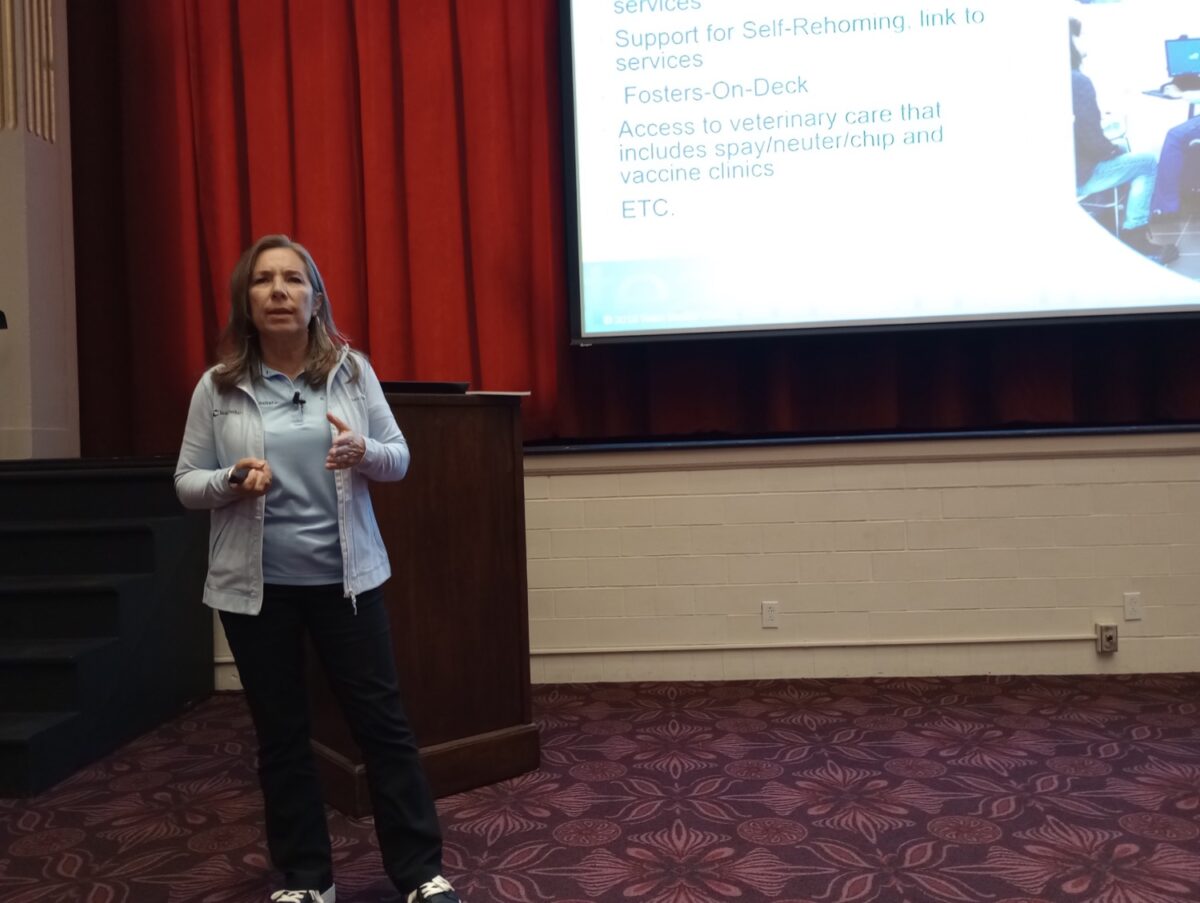Sara Pizano told about 60 people July 18 that Wayne County’s animal welfare problems are not unique.
They’re the same problems the animal welfare strategist finds in communities across the country. The good news, Pizano said, is that there are solutions.
“I promise you that everything you’re facing here is common to every other organization and community,” Pizano said. “The difference is scale. The beauty of this is we can tell you that solutions work everywhere.”
Pizano touted industry standards and answered questions during her hourlong presentation in Richmond High School’s McGuire Hall. Money committed to the Hoosier Enduring Legacy Program funded Pizano’s study of the county’s animal welfare situation as one of HELP’s 33 projects.
She said partnerships and collaboration that include city and county governments and the area’s animal welfare organizations will be necessary to address issues such as alleviating full shelters, providing access to veterinary care and increasing adoptions. City and county government officials attended the presentation.
Pizano presented the ideas, but she could not supply what really makes solutions possible: money.
“This woman has a lot of great ideas, I get that, but we’re still at the point where there’s no money to do it,” said Carol Hulett, a board member for HELP the Animals. “Most of us in the nonprofits are busting our butts on a daily basis just to keep the doors open. We don’t have vet services. We can’t find the vets.”
Access to veterinary care is a crisis across the country, Pizano said. Bringing outside vets to a community for a day or weekend often is necessary; subsidizing care, such as spay/neuter and vaccines, helps pet owners. She said 29 million pet owners are on government assistance nationwide, and others beyond that struggle to afford pet care.
When there are veterinarians available to spay/neuter pets, Pizano said the priorities should be large breed dogs that have large litters of hard-to-adopt puppies, socioeconomically challenged owners and cats with outside access.
Helping pet owners might enable them to keep pets rather than surrendering them at shelters. Pizano said 89% of people surrendering pets indicated that if they received temporary help, they could have kept their pets. When a pet owner comes to a shelter, asking what they need and connecting them to services might keep the pet in the home. Similarly, animal control officials might provide links to services and avoid animals being sheltered.
On the other end, shelters can remove barriers that prevent adoptions. Pizano said 76% of people acquiring a pet from a pet store or breeder said they had visited a shelter to adopt, but the process was too difficult or invasive, or they were denied.
“Remember how easy it is to get into a shelter?” Pizano said. “We need to make it as easy to get out.”
Shelters have horror stories about bad adoptions, but Pizano said they should trust that people adopting animals are good. In addition, counseling the adopters before and after adoption helps them adapt to and keep their pets.
Having fewer pets surrendered to shelters and making adoption easier creates more space in shelters, Pizano said. That enables better accommodations in the shelter, reducing stress and improving health.
“We want to ensure they’re in a fear-free environment and they’re in and out as quickly as possible,” Pizano said. “Nobody wants to be confined. Not people, and not animals.”
Another way to free up shelter space is to stop sheltering healthy-looking cats, Pizano said. She called cats “shysters” and said they always know where to get meals and rarely get lost.
“We need to use our shelter space for animals who really need help,” Pizano said. “We have sick animals, injured animals, ones who are victims of cruelty and neglect, maybe they’re court cases.”
Animals should only be sheltered after exhausting all other options.
“We still have never heard what she said about how do you do this,” said Hulett, who admitted being frustrated the assessment did not provide a bigger solution. “Do you put all the shelters together? What do we do? Are we wasting money because we have all these separate little groups?”
Sue Boxell and Rayanna Spalding help animals in Richmond’s Baxter neighborhood. They’ve had 10 outdoor cats spayed or neutered in two months and feed many animals. Spalding said three cats and a dog have had litters all at the same time.
“They deserve to eat,” she said. “They’re all God’s creatures.”
Boxell said costs for food are increasing and it’s difficult to get spay/neuter appointments when a new cat shows up, and they’re always out of town. She thinks the city should give incentives to attract veterinarians. The women take care of more animals than anyone should care for, Boxell said.
“I’m not a rescue, but I’m not going to allow needless suffering if I can do something to help,” she said.
Now, Boxell said action is needed from the assessment for there to be animal welfare progress.
“As long as they put their money where their mouth is,” she said. “You’ve done this wonderful study. It all sounds wonderful, and there is so much benefit to this community that could be had.”
A version of this article appeared in the July 24 2024 print edition of the Western Wayne News.

